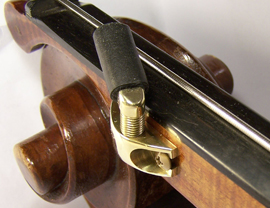For a price quote and further information, contact [email protected]
Please tell me what country you are in.

Question: Is this a "kit", and does it have everything I need?
Answer: No. I only supply the brass hardware. Your luthier must carve and fit the wood extension body. To do this he must have access to your bass.
Q: Can a C-extension be fitted to my bass?
A: In most cases, yes. The ease of which an extension can be fitted depends on the shape of the scroll and pegbox, and the thickness of the fingerboard. There are a few basses in which the scroll sticks so far forward that there is no room for the extension body. This is rare however. If you want to have an extension, your best bet is to locate a luthier who has made them before, and show him your bass. He should quickly be able to tell you how suitable your bass is for an extension.
Q: Can an extension damage my bass or hurt the sound?
A: No. There is a common misconception that a C-Extension adds tension to the top. This is mostly false. There is nothing inherent about an extension which changes the downforce on the bridge. Now, the tension of the extended string in some sets is indeed slightly higher than the standard length E-String, but not excessively so. With Thomastic strings, for example, the "Long-E" in a "Mittel" set is actually the same tension as a normal "Stark" E. With D'Addario and Pirastro strings the tension is unchanged. In any case, the effect on the top tension is either unchanged or only very slightly increased. As far as sound goes, any experienced extension builder will tell you that in almost all cases the player reports an overall improvement after getting an extension. I can't say why this is, but perhaps it's that the low tones vibrate the top in new ways and cause it to open up more.
Q: Do I need to cut or drill my scroll to add an extension?
A: Cutting away part of the scroll to fit an extension is something that was done decades ago, but no self-respecting luthier would do it today. Drilling through the scroll is still done by many luthiers to get the string back to the tuner. There are ways to route the string back into the pegbox without making a hole using secondary pulleys, tubes, etc. but drilling is usually the simplest and cheapest option.
Q: Can I install Bass Capos myself?
A: Yes and no. If your fingered extension is flat on the side you may indeed be able to install the Capos yourself, but unless you are an experienced woodworker or at least handy with tools, I'd leave it to a pro. Installation is usually quick and easy for an experienced luthier, so the cost should be quite low. Installing the E-Stop is a bit more involved. A reasonable gauge might be if you have ever fitted a nut yourself. If so, then you can probably install both Capos and an E-Stop yourself!
Please tell me what country you are in.